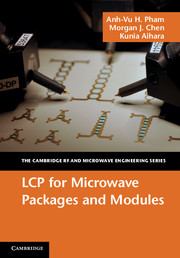Book contents
- Frontmatter
- Contents
- Preface
- 1 Introduction to electronic package engineering
- 2 Characteristics of liquid crystal polymer (LCP)
- 3 Fabrication techniques for processing LCP
- 4 LCP for wafer-level chip-scale MEMS
- 5 LCP for surface mount interconnects, packages, and modules
- 6 LCP for passive components
- 7 LCP for system design
- 8 LCP reliability
- Abbreviations, acronyms, and symbols
- Index
- References
8 - LCP reliability
Published online by Cambridge University Press: 05 July 2012
- Frontmatter
- Contents
- Preface
- 1 Introduction to electronic package engineering
- 2 Characteristics of liquid crystal polymer (LCP)
- 3 Fabrication techniques for processing LCP
- 4 LCP for wafer-level chip-scale MEMS
- 5 LCP for surface mount interconnects, packages, and modules
- 6 LCP for passive components
- 7 LCP for system design
- 8 LCP reliability
- Abbreviations, acronyms, and symbols
- Index
- References
Summary
In this chapter we evaluate the long-term functionality of LCP packages and the protection they offer against external environments. This emerging flex material has ultra-low moisture absorption and permeation close to that of glass. It is an attractive material for making hermetic packages that can provide reliability in a low-cost and lightweight platform. Prototype LCP packages for RF to millimeter-wave frequencies have been reported recently [1–13]; the emphasis in these publications has been primarily on electrical characteristics, with less focus on the reliability aspects. Among the limited list of publications [7–13], some authors claim that LCP can be used for hermetic packages with long-term reliability. Other groups, including the authors of [13], have performed environmental tests such as measuring the water absorption of LCP-cavity packages by submerging them in water. In this chapter, a variety of reliability tests and results on an LCP package will be reported using standard tests recognized as being required for military and commercial products.
A primary hurdle for LCP packaging, or any hermetic packaging in general, is achieving a high-quality lid-seal process. This hurdle can be exacerbated by LCP’s inert chemical properties, which require a careful approach to processing. In a commercially available LCP-molded lead-frame package, a lid may be attached to a base using epoxy. In an epoxy-sealed package, a typical lid attachment process includes a cure cycle, i.e. 5 psi at 165°C for one hour [6]. Moisture can readily and detrimentally pass through this epoxy layer. In ultrasonic-welded packages, the width of the lid interface to the base must be narrow enough for it to accumulate sufficient ultrasonic energy and melt the LCP. In addition, molding small features in LCP is challenging, as the features may be too thin to form a reliable seal. For these various reasons, and given LCP’s short history, it is not surprising that the leak rate and reliability of LCP packages have not been reported extensively in the literature.
- Type
- Chapter
- Information
- LCP for Microwave Packages and Modules , pp. 226 - 241Publisher: Cambridge University PressPrint publication year: 2012



